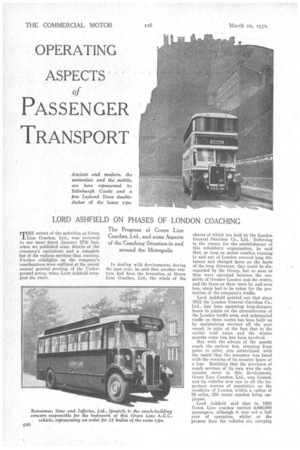OPERATING ASPECTS
Page 62

Page 63

If you've noticed an error in this article please click here to report it so we can fix it.
of
PASSENGER TRANSPORT
THE extent of the activities of Green Line Coaches, Ltd., was reviewed in our issue dated January 27th last, when we published some details of, the company's operations and a complete list of the various services then running. Further sidelights on the company's ramifications were outlined at the recent annual general meeting of the Underground group, when Lord Ashfield occupied the chair. The Progress of Green Line Coaches, Ltd., and some Aspects of the Coaching Situation in and around the Metropolis In dealing with developments during the past year, he said that another venture had been the formation of Green Line Coaches, Ltd., the whole of the
shares of which are held by the London General Omnibus Co., Ltd. Referring to the reason for the establishment of this subsidiary organization, he said that, so long as motor coaches running in and out of London covered long distances and charged fares on the basis of the long distances, they could be disregarded by the• Group, but so soon as they were operated between the outskirts of Greater London and the centre, and the fares on them were 1s. and even less, steps had to be taken for the protection of the company's traffic.
Lord Ashfield pointed out that since 1912 the London General Omnibus Co., Ltd., has been operating long-distance buses to points on the circumference of the London traffic area, and substantial traffic on these routes has been built up by maintaining services all the year round, in spite of the fact that in the earlier trial years and the winter months some loss has been involved.
But with the advent of the speedy coach the patient bus, stopping from point to point, was outstripped, with the result that the company was faced with the running of its country buses at a loss. Realizing that the provision of coach services of its own was the only counter move to this development, Green Line Coaches, Ltd., was formed, and its vehicles now run to all the important centres of population on the outskirts of London within a radius of 30 miles, 250 motor coaches being employed.
Lord Ashfield said that in 1930 Green Line coaches carried 4,000,000 passengers, although it was not a full year of operation, -whilst at the present time the vehicles ire carrying passengers at the rate of nearly 200,000 per week.
In making observations on the coach business in London, he said that a long-distance coach corresponds to a main-line train; the objective is London and not some particular point of attraction in London. In his opinion, the terminal point can quite well be a station conveniently placed for the transfer of passengers to some local means for conveyance for the completion of their journey.
Following up this theme, he said that the vehicle' of 'Green Line Coaches, Ltd., are running on services which can be described as being local in character ; they bring people from the outskirts of the Metropolis to their places of business, to the shops, to the theatres, etc., and their passengers cannot be expected to change from one vehicle to another to complete what is a comparatively short journey.
Lord Ashfield objected to the denying of the use of the streets to one form of passenger transport.












































































































